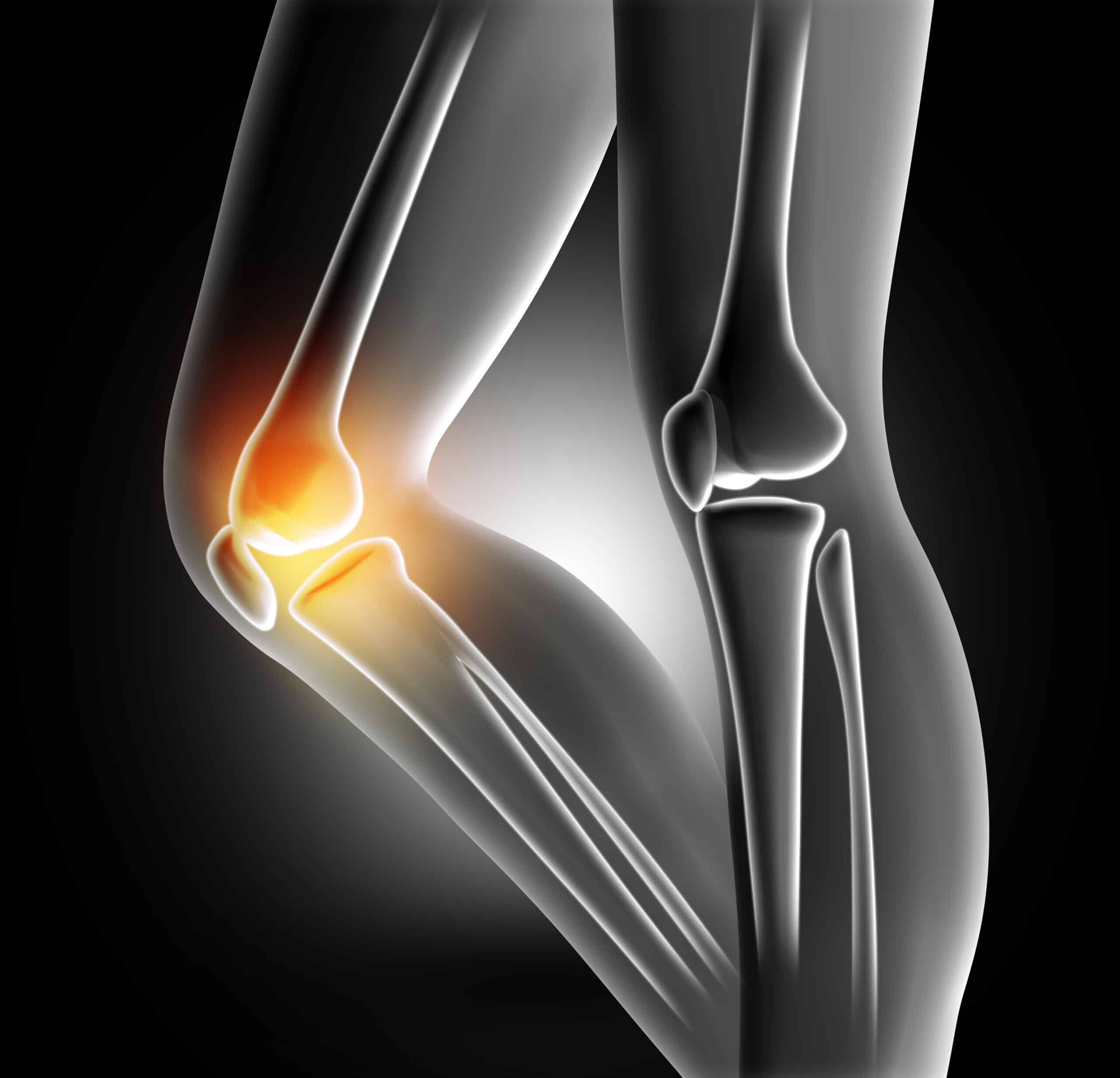Osteoarthritis - What is it? How does it develop?
Osteoarthritis stands as the most prevalent form of arthritis, characterized by its chronic nature, often emerging as a consequence of age-related joint deterioration. This condition primarily arises due to the wear and tear endured by joints and a lack of physical activity, leading it to be colloquially referred to as “wear and tear arthritis.”
When the cartilage, the resilient protective layer cushioning joint ends and serving as a shock absorber, becomes compromised or damaged, joint friction ensues. This friction gives rise to discomfort, rigidity, and a host of other symptoms. Osteoarthritis can manifest in various joints throughout the body, including hips, knees, wrists, spine, and even fingers. Rest assured, the adept physiotherapists at Huronwood Physio & Rehab possess the expertise and training necessary to guide you in managing and alleviating your osteoarthritis symptoms.

How does a healthy knee joint look like?
Let’s delve into an illustrative example to better understand the concept – taking a closer look at the largest joint in our body, the knee joint, and exploring what a healthy knee joint entails. The knee joint plays a pivotal role in our daily movements, enabling extension and flexion as we navigate our routines. As depicted in the image on the left, the knee joint comprises vital components such as cartilage, bone, fibrous and synovial articular capsules, as well as ligaments.
Osteoarthritis, in essence, is characterized by the gradual erosion of articular cartilage. Interestingly, cartilage itself lacks nerves; however, its deterioration contributes to friction between adjacent bones, intensifying the discomfort that defines osteoarthritis.
Age stands as a significant factor in its development, but recent research highlights that a sedentary lifestyle, obesity, and insufficient physical activity escalate the likelihood of osteoarthritis, particularly in weight-bearing joints like the hip, knee, and spine.
The manifestation of osteoarthritis can vary across individuals, with certain groups more predisposed to its onset. Individuals with desk-bound professions may be susceptible to joint issues in the elbows or wrists, while those engaged in strenuous lifting tasks could potentially develop osteoarthritis in the hip or knee. Consequently, the combination of joint overuse, a lack of physical activity, and the natural aging process contribute to the breakdown or damage of cartilage, leading to symptoms such as stiffness, pain, inflammation, and diminished joint mobility.
Intriguingly, some individuals might be more genetically prone to developing osteoarthritis than others. Therefore, a comprehensive understanding of these factors is essential for managing and addressing the challenges posed by osteoarthritis.
What is the difference between osteoarthritis and arthritis?
Rheumatoid arthritis and osteoarthritis belong to the realm of arthritis, sharing certain resemblances yet diverging in their underlying causes for joint-related manifestations. Osteoarthritis materializes due to mechanical and ergonomic wear and tear, while rheumatoid arthritis emerges as an autoimmune ailment that can impact numerous joints throughout the body.
The trajectory of onset in rheumatoid arthritis is notably swifter, spanning from a matter of weeks to several months. In contrast, osteoarthritis exhibits a more gradual progression, with its symptoms occasionally waxing and waning over time.
Symptoms of Shoulder Osteoarthritis
It is widely recognized that various forms of arthritis contribute to joint discomfort. Among the most frequently cited symptoms reported by individuals grappling with osteoarthritis are sensations of soreness, stiffness, tenderness, and pain. Additionally, a notable sense of discomfort and restricted mobility often characterizes this condition.
Morning stiffness or stiffness following extended periods of rest is a common occurrence. However, the encouraging news is that physiotherapy exercises can serve as a potent remedy to alleviate such discomfort. The adept physiotherapists at Huronwood Physio are equipped to conduct comprehensive ergonomic evaluations of all bodily joints, subsequently devising a tailored, efficacious physiotherapy regimen. This approach aims to diminish symptoms and enhance joint mobility.
Instances of instability, a sense of looseness, or an inclination for joints to give way are indicative signals that warrant thorough assessment. It is our earnest recommendation not to endure pain needlessly—reach out to us today for assistance.
What are the treatment options for osteoarthritis?
The treatment of osteoarthritis is centered on alleviating primary symptoms and enhancing joint functionality through well-rounded approaches such as comprehensive education, appropriate exercises, and potential weight management. Extensive research underscores physiotherapy and exercises as the foremost avenues for effectively addressing osteoarthritis.
At Huronwood Physio & Rehab, our team of dedicated and proactive physiotherapists is unwavering in their commitment to patient well-being. With meticulous assessments, they devise customized physiotherapy treatment plans tailored to each individual’s unique health goals and requirements.
Each member of our accomplished physiotherapy team comprehends the profound impact that optimal joint function can exert on daily life. Hence, at Huronwood Physio & Rehab, we offer an array of services aimed at assisting patients in overcoming key symptoms and regaining strength.
As previously mentioned, education, exercises, and weight management form the frontline of treatment. Should these measures fall short of delivering sufficient relief, physiotherapists can extend their support as the next line of defense. This may be supplemented by pain relief medications, Transcutaneous Electrical Nerve Stimulation (TENS), manual therapy, orthoses, shoe insoles, and assistive devices. Surgery is reserved as a consideration for those with severe symptoms.
Our integrated approach ensures that patients receive comprehensive care, fostering a journey towards enhanced well-being and quality of life.
How can Huronwood Physio & Rehab can help you?
Osteoarthritis can significantly impede your ability to carry out daily activities, and we fully understand the frustration this can cause. The good news is that physiotherapy holds the potential to effectively manage osteoarthritis pain and even circumvent the need for surgery.
At Huronwood Physio & Rehab, our team of skilled and seasoned physiotherapists is well-versed and adept in evaluating and treating osteoarthritis. An experienced physiotherapist will conduct a comprehensive assessment of your condition, gauging your range of motion and discussing the symptoms you’re experiencing. Subsequently, a personalized treatment plan will be crafted by the physiotherapist to specifically target your unique condition.
Your physiotherapist will also provide comprehensive education on various strategies to manage the condition, encompassing exercises, weight management, injury and fall prevention, and more. You’ll also receive a home exercise plan to follow, along with additional sessions for hands-on physiotherapy, manual therapy, shockwave therapy, massage therapy, chiropractic care, and other tailored approaches.
The ultimate goal of your treatment plan will be to alleviate pain, enhance your range of motion, and bolster your strength, enabling you to regain a sense of normalcy in your daily life. If you’re located in the Waterloo and Kitchener Region, we warmly invite you to visit our Waterloo clinic. Our team is more than happy to address any specific queries you may have, and we’re dedicated to assisting you on your path to recovery.
What are some measures that one can take to prevent osteoarthritis?
While complete prevention of osteoarthritis may not be feasible, you can certainly take steps to reduce your risk of developing the condition by adopting a healthy lifestyle and minimizing the chances of injuries.
Maintaining a Healthy Weight: The first step is maintaining a healthy weight. Excess weight can lead to increased pressure on the lower body, including hips, knees, ankles, and feet. If you’re overweight, consult your doctor or physiotherapist for guidance on safe exercises to help you achieve and sustain a healthy weight. Our experienced team can provide you with valuable advice on effective exercises to support your weight loss journey.
Controlling Blood Sugar: High blood sugar levels are associated with a higher risk of osteoarthritis. If you have diabetes, managing your sugar levels is crucial. Staying active for even 20 minutes after meals can help control sugar levels. It’s essential to follow your healthcare provider’s instructions and recommendations to prevent excessive sugar levels.
Staying Active: Regular exercise plays a pivotal role in preventing joint issues. It helps maintain flexibility, reduces stiffness, and strengthens muscles – all vital for managing arthritis. Aim for at least 30 minutes of exercise on most days. Consult your healthcare provider or our physiotherapists at the Waterloo clinic to determine suitable and safe exercise options for you.
Preventing Injuries and Falls: Avoiding joint injuries is pivotal in reducing the risk of osteoarthritis. When starting an exercise routine, begin gradually and increase intensity over time. Prior to each workout, spend 5 to 10 minutes warming up with gentle stretches to prevent injury to muscles, ligaments, and tendons. Vary your exercise routines to distribute stress across different joints and prevent overuse of specific ones. Be cautious of daily activities that strain your joints. For instance, carrying heavy bags close to your body can be less straining than holding them with your hands. When using exercise equipment or protective gear, ensure it’s properly fitted and comfortable.
By incorporating these lifestyle practices, you can take proactive steps towards reducing your risk of developing osteoarthritis and promoting overall joint health. Feel free to reach out to our experienced team for personalized guidance and assistance in making these practices a part of your routine.
What food should you avoid in osteoarthritis?
Osteoarthritis is a non-inflammatory health condition, yet studies indicate that certain dietary interventions, such as reducing the consumption of specific foods and beverages, can have a positive impact on mitigating the severity of pain and stiffness associated with osteoarthritis.
It’s advisable to limit the consumption of processed foods that are high in added sugars and salt. Foods to be cautious of include red meat, processed meats, ice cream, candy, soda, canned foods with high salt content, and certain types of cheeses. Additionally, it’s important to note that chronic alcohol consumption is linked to an increased risk of osteoarthritis.
Making informed dietary choices by reducing the intake of these types of foods and beverages can contribute to the management of osteoarthritis symptoms and promote better joint health. If you have specific dietary concerns or would like guidance on creating a balanced diet that supports your joint health, our experienced team is here to provide personalized recommendations and support.

